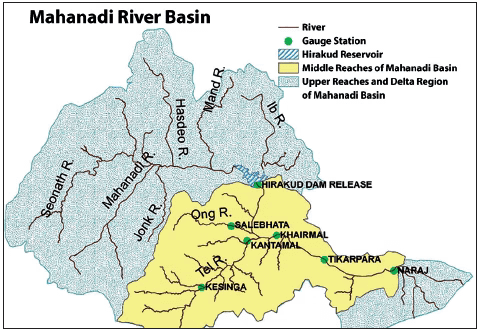The Mahanadi River is one of the most important rivers in East-Central India. Known for its vast irrigation network and hydroelectric potential, it sustains millions of lives and landscapes across Chhattisgarh and Odisha. From its origin point in the highlands of Chhattisgarh to its mouth at the Bay of Bengal, the Mahanadi weaves through history, culture, and agriculture.
Let’s explore the origin of Mahanadi River, where it originates from, and understand the major tributaries that enrich this mighty watercourse.
Where Does the Mahanadi River Originate From?
Wondering where the Mahanadi originates from? Here’s your answer.
The Mahanadi River originates in the Dandakaranya region of Chhattisgarh, near the village of Pharsiya in Raipur district. The origin of Mahanadi River is situated at an altitude of approximately 442 meters (1,450 feet) above sea level.
If you’re looking for the Mahanadi origin place, remember this: Pharsiya village in Chhattisgarh—that’s where the journey begins.
Course of the Mahanadi River
After its birth in Chhattisgarh, the Mahanadi carves a majestic path eastward:
- It flows through Chhattisgarh, entering Odisha after merging with the Seonath River.
- The Hirakud Dam at Sambalpur—one of India’s largest—forms a massive artificial lake.
- The river meanders through Odisha’s fertile plains, especially near Cuttack.
- Finally, it empties into the Bay of Bengal at False Point, through multiple distributaries. One of the outlets is near Puri, a prominent pilgrimage destination.

Tributaries of the Mahanadi River
The Mahanadi River tributaries are what truly power this river system. These tributaries can be classified into left bank and right bank tributaries.
🔹 Left Bank Tributaries of Mahanadi River
These rivers join the Mahanadi from the north and west:
- Seonath River – Originates from Panabaras Hill (625 m); crucial for the Durg district.
- Hasdeo River – Flows through Bilaspur and Korba; a lifeline for agriculture and industry.
- Mand River – Joins the Mahanadi from the central highlands.
- Ib River – Rises from the hills in Raigarh district of Chhattisgarh.
🔸 Right Bank Tributaries of Mahanadi River
These rivers merge into the Mahanadi from the south and east:
- Ong River – Originates in the Eastern Ghats; sustains irrigation in Odisha.
- Tel River – Begins in Kalahandi, Odisha; joins Mahanadi near Sonepur.
- Jonk River – Arises from the Khariar plateau in Odisha; flows through Chhattisgarh.
Each of these tributaries enhances the river’s volume, making the Mahanadi one of the largest silt-depositing rivers in India.
Cities on the Banks of Mahanadi River
Several major cities thrive along the banks of the Mahanadi:
- Raipur (Chhattisgarh)
- Durg (Chhattisgarh)
- Cuttack (Odisha)
These cities have evolved around the river, drawing sustenance from its water for industry, agriculture, and daily life.
🏗️ Major Dams on Mahanadi River
✅ Hirakud Dam – Located in Sambalpur, Odisha; one of the largest multipurpose river valley projects in India.
✅ Gangrel Dam (R.S. Sagar) – Situated in Dhamtari, Chhattisgarh; supplies water for irrigation and drinking.
✅ Dudhwa Dam – Another crucial project in Dhamtari, supporting regional irrigation.
Industries in the Mahanadi Basin
Thanks to its rich water and mineral resources, the Mahanadi River Basin has become a hub for industry:
- Bhilai Steel Plant
- Aluminium factories at Hirakud and Korba
- Paper mill near Cuttack
- Cement factory at Sundargarh
- Coal, iron, and manganese mining
The basin also hosts agro-based industries like sugar and textile mills.
Why Is the Mahanadi River Important?
- Supports agriculture over 54% of the basin
- Powers hydroelectric plants
- Enables irrigation in two major states
- Feeds industries and cities
- Sustains wetlands, biodiversity, and fisheries
FAQs on Mahanadi River
Q1. Where does Mahanadi River originate from?
Ans: The Mahanadi originates from Pharsiya village in the Dandakaranya Plateau, Raipur district, Chhattisgarh.
Q2. What is the origin place of Mahanadi River?
Ans: The origin of Mahanadi River is in Chhattisgarh, near Pharsiya village at 442 meters above sea level.
Q3. What are the main tributaries of Mahanadi River?
Ans: Left bank – Seonath, Hasdeo, Ib, Mand; Right bank – Ong, Tel, Jonk.
Q4. Which states does the Mahanadi River flow through?
Ans: The river flows primarily through Chhattisgarh and Odisha.
Q5. Which dam is built on Mahanadi River?
Ans: The Hirakud Dam is the most famous dam on the Mahanadi River.
Final Thoughts
From its origin in Chhattisgarh to its vast delta in Odisha, the Mahanadi River system is more than a geographical feature—it’s a cultural lifeline, an economic engine, and an ecological treasure. Understanding the tributaries of Mahanadi, its origin, and its role in regional development is crucial to appreciating the legacy of this ancient river.